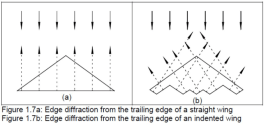I tried my best to overlay the scales on top of each other for layout A the cranked kite versus Layout D like the B-21. We can see that on average Layout D has lower dbsm across most angles, all except from the peak at 30 degrees where all the edges line up for Layout D.

Apart from a hopeless diamond, Layout D is the most optimal planform for observability reduction. It's not at all a surprise that the B-21 is shaped exactly like this.

Apart from a hopeless diamond, Layout D is the most optimal planform for observability reduction. It's not at all a surprise that the B-21 is shaped exactly like this.

